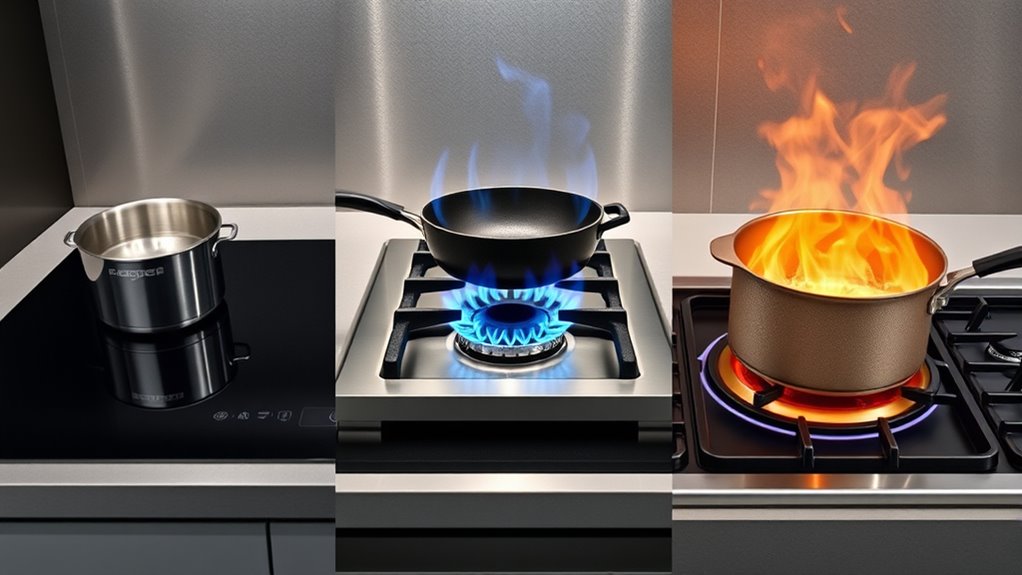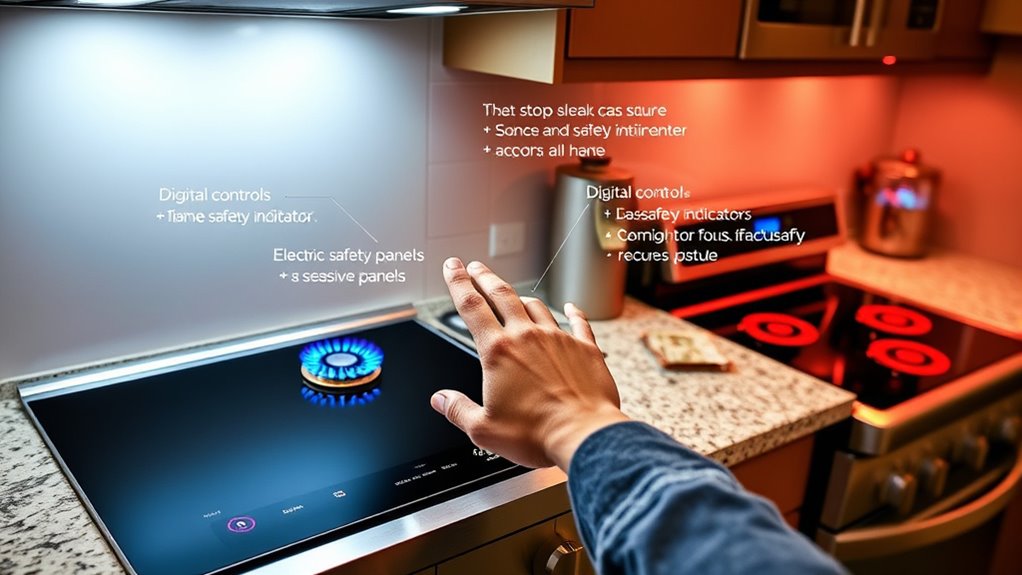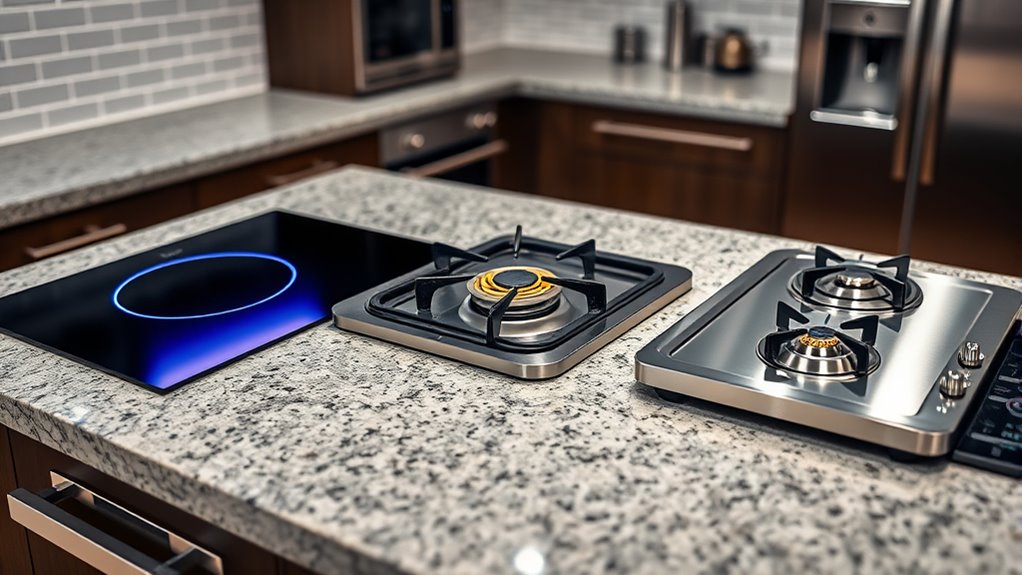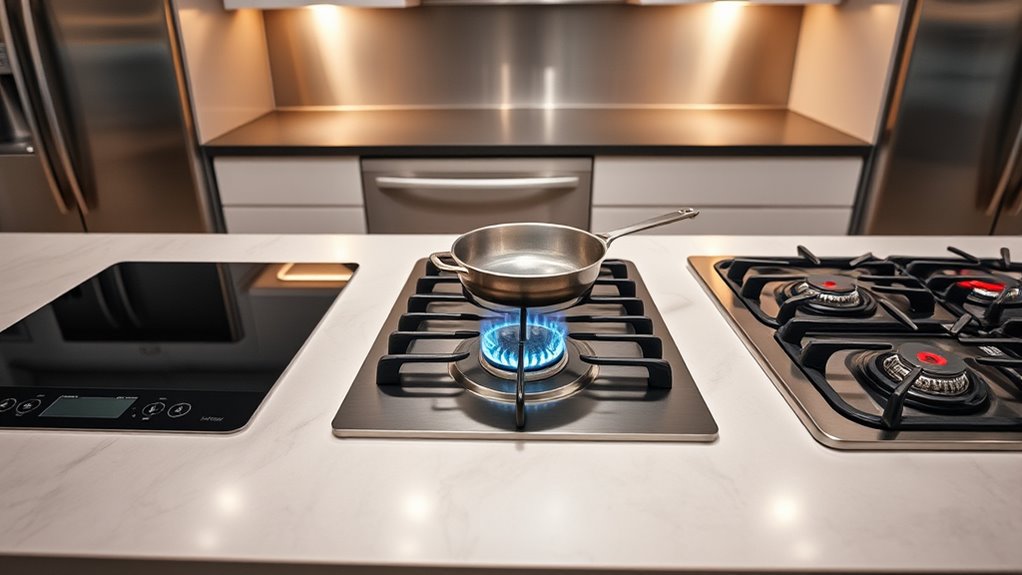When choosing between induction, gas, and electric stoves, consider your priorities. Induction heats quickly, offers precise control, and is safer with smart features, but costs more upfront and needs compatible cookware. Gas stoves are affordable and easy to install, yet less safe and less efficient. Electric stoves provide balanced performance and easier maintenance. To find out which option best fits your needs and kitchen, keep exploring the key differences.
Key Takeaways
- Induction stoves offer faster heating, precise control, and energy efficiency compared to gas and electric options.
- Gas stoves are typically cheaper upfront but have higher ongoing fuel costs and safety concerns.
- Electric stoves are easy to install and maintain but generally slower and less efficient than induction.
- Induction surfaces are durable, resistant to wear, and include safety features like hot surface indicators.
- Cost considerations involve initial investment versus long-term savings, with induction often more economical over time.
Comparing Cooking Efficiency and Performance

When comparing cooking efficiency and performance, induction stoves often lead the way because they heat cookware directly through electromagnetic energy, resulting in faster and more precise temperature control. This efficiency means you’ll spend less energy overall, reducing your energy consumption compared to electric or gas options. Induction cooktops are known for their durability—since their surfaces are smooth and solid, they resist wear and tear better over time. Their rapid heating and cooling minimize thermal stress, helping maintain the cooktop’s integrity longer. Plus, because heat is generated directly in the cookware, heat loss is minimal, making cooking more efficient. Additionally, induction technology can support emotional support by providing a safer and more reliable cooking experience, especially important in households with children or individuals with special needs. Overall, induction stoves excel in delivering high performance, saving energy, and offering durable, long-lasting cooktop surfaces.
Safety Features and User Experience

Induction stoves prioritize safety and ease of use by incorporating features like hot surface indicators and automatic shut-off systems, which help prevent accidents. These safety features are especially important for child safety, reducing risks of burns or fires if little ones accidentally touch the cooktop. The user interface on induction models is typically intuitive, with touch controls and clear displays that make operation straightforward. Gas stoves lack these safety indicators, requiring more vigilance, while electric stoves often have simpler controls but fewer safety alerts. Overall, induction provides a safer, more user-friendly experience, giving you peace of mind while cooking. Its focus on safety features and a streamlined user interface makes it a compelling choice for modern kitchens. Additionally, many induction models include safety certifications, ensuring they meet strict safety standards and further enhance user confidence.
Cost, Installation, and Maintenance Considerations

While safety features enhance user experience, considering the cost, installation, and maintenance of each stove type is equally important for making an informed choice. The cost comparison varies: gas stoves often have lower upfront prices but higher energy bills, while induction and electric stoves may be more expensive initially but save energy over time. Installation requirements differ: gas stoves need proper ventilation and professional setup, whereas electric and induction units are easier to install. Maintenance tips include cleaning burners regularly and checking for wear. Remember, energy consumption impacts long-term expenses. Additionally, understanding different security testing methodologies can help in assessing potential vulnerabilities more effectively. To summarize:
- Gas stoves generally have lower initial costs but higher ongoing energy costs.
- Electric and induction models may require professional installation.
- Maintenance involves cleaning and inspecting components periodically.
- Energy efficiency can considerably reduce your overall expenses.
Frequently Asked Questions
Which Cooktop Type Is Best for Professional Chefs?
When choosing the best cooktop for professional chefs, consider their preferences for cooking precision and control. Many prefer induction for quick, precise temperature adjustments, helping them achieve consistent results. Gas cooktops are favored for their instant heat response, ideal for techniques requiring visual control. Electric options offer steady heat but lack the responsiveness of gas or induction. Ultimately, your choice depends on your cooking style and need for accuracy.
How Do Different Cooktops Impact Energy Consumption Over Time?
You’ll notice that different cooktops impact your energy consumption differently over time. Induction cooktops are highly energy-efficient, heating quickly and using less power, which leads to significant cost savings. Gas cooktops tend to be less efficient, with more heat loss, increasing energy costs. Electric options fall somewhere in between, but choosing an energy-efficient model can still help you save money and reduce your environmental footprint over time.
Are Induction Cooktops Suitable for All Cookware Types?
Sure, induction cooktops are compatible with most cookware, right? Well, not quite. You’ll find that cookware compatibility actually varies, often requiring ferrous metal pans for energy efficiency. It’s ironic—your shiny new induction might be wasting energy because of incompatible pots. So, before you buy, check if your cookware is induction-ready to truly enjoy the energy-efficient magic it promises. Otherwise, you’ll just be heating the air instead of your food.
What Are the Environmental Impacts of Each Cooktop Technology?
You’re curious about the environmental impacts of each cooktop technology. Induction cooktops are highly energy-efficient, using less power and producing fewer emissions, which helps with emissions reduction. Gas stoves emit more pollutants and carbon dioxide, impacting air quality and climate. Electric cooktops vary in efficiency, but generally, they can be less environmentally friendly depending on the energy source. Choosing an induction cooktop supports sustainability with its better energy efficiency and lower emissions.
Can I Retrofit My Kitchen With Any of These Cooktop Types Easily?
You can retrofit your kitchen with different cooktop types, but each has its retrofit challenges and installation complexities. Gas cooktops often require updates to your gas line and proper ventilation, making installation more involved. Electric options might need electrical upgrades, especially for higher wattage models. Induction cooktops generally demand compatible cookware and may require electrical system adjustments. Assess your existing setup and consult professionals to guarantee a smooth, safe retrofit process.
Conclusion
Choosing between induction, gas, and electric depends on your priorities. Induction offers 90% energy efficiency, making it the quickest and most responsive option, while gas provides a traditional feel with better control. Electric stoves are budget-friendly but less efficient. Consider safety features and maintenance needs before deciding. Ultimately, selecting the right cooktop can save you time and money—did you know induction stoves can reduce energy use by up to 50% compared to electric?









